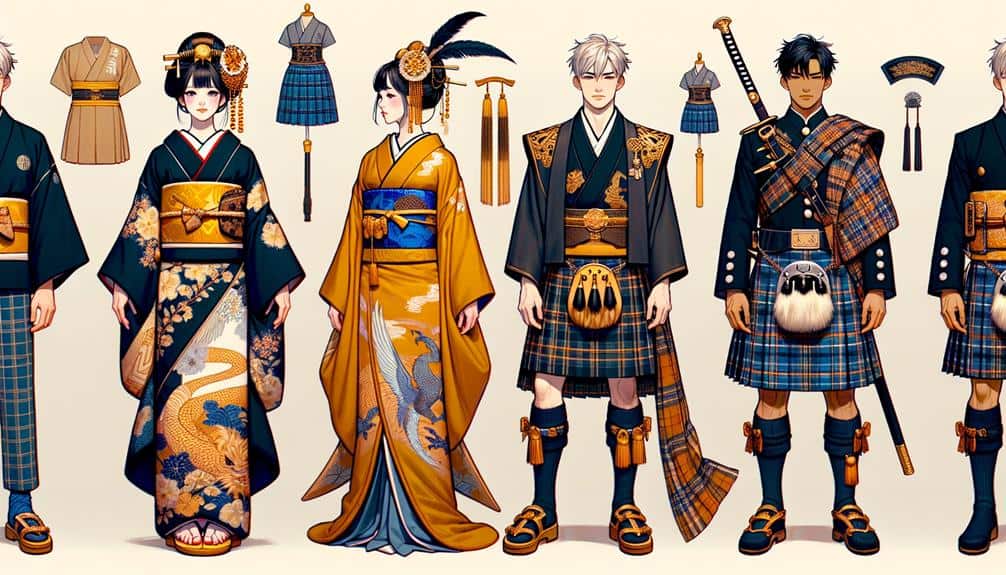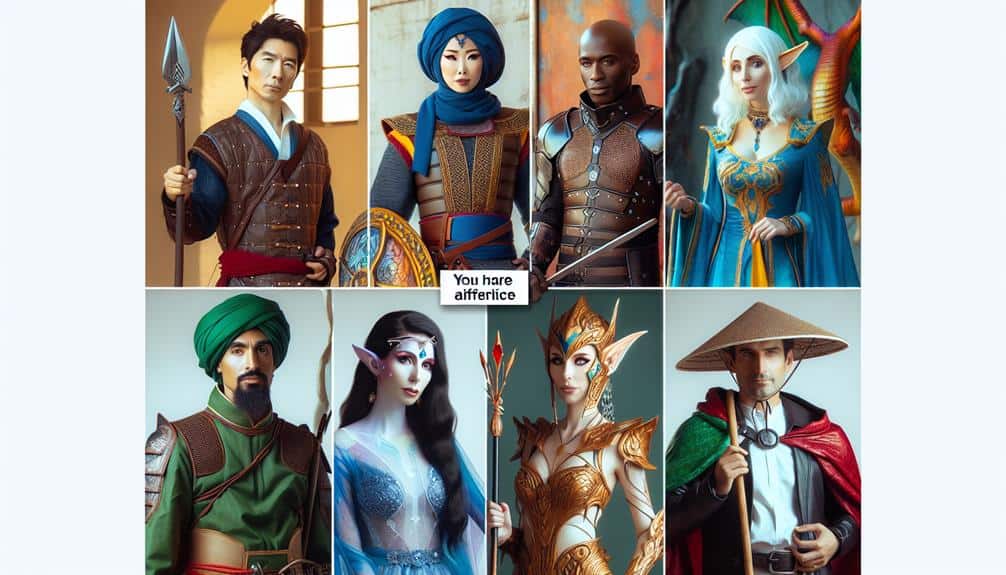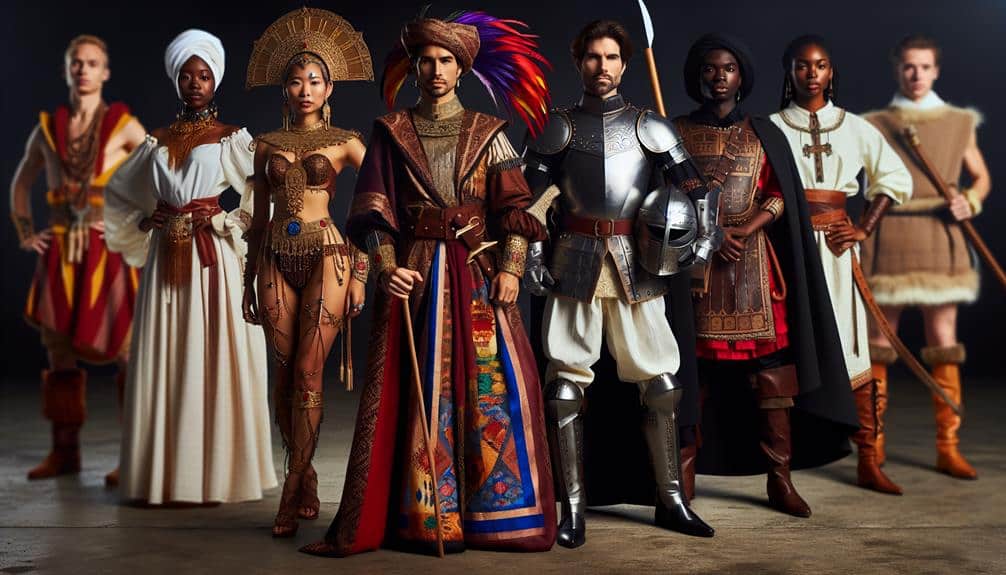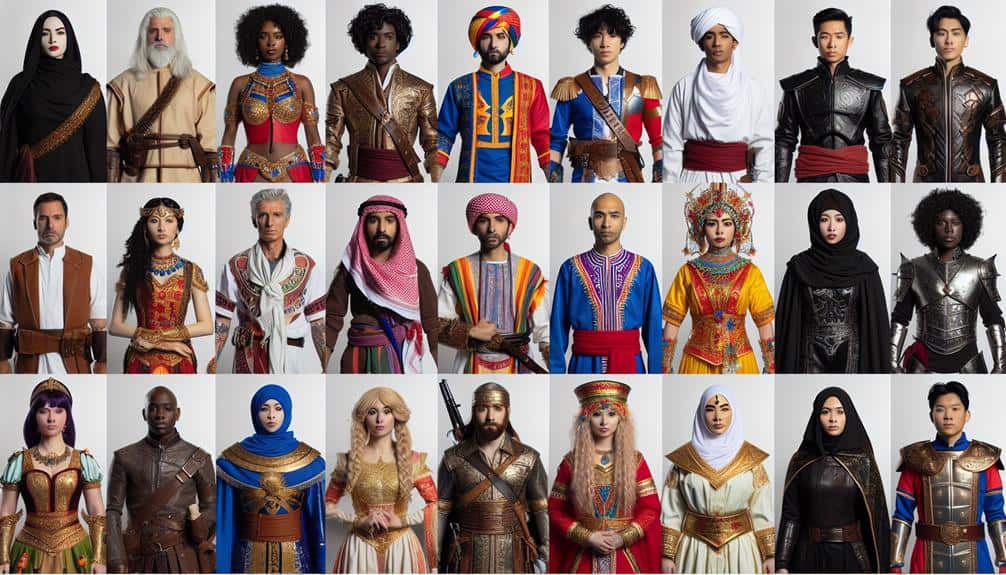So you think throwing on a kimono and calling it a day is enough for a cultural cosplay? Think again. Immerse yourself in the intricate world of cultural accuracy in cosplay costumes, where each stitch and accessory can make or break your portrayal.
From meticulous research to understanding the significance behind each element, there are key factors that go beyond the surface level of dressing up. Stay tuned to unravel the secrets behind truly capturing the essence of a character's cultural identity through your cosplay attire.
Key Takeaways
- Thorough research on character backgrounds and cultural significance is crucial for accurate portrayal.
- Using authentic materials and techniques enhances cultural accuracy in costumes.
- Consulting with cultural experts ensures respectful representation of diverse cultures.
- Balancing between appropriation and appreciation while maintaining cultural sensitivity is essential in cosplay.
Importance of Research in Cosplay
To excel in cosplay, thorough research is paramount to accurately embodying characters. Research methods play an important role in ensuring historical accuracy within the world of cosplay. When exploring a character's background, it's imperative to utilize reliable sources such as original artworks, official merchandise, and creator interviews. These resources offer valuable insights into the character's personality, attire, and overall aura, aiding in the creation of a culturally accurate cosplay costume.
Understanding Cultural Significance
Exploring the cultural significance behind the characters you cosplay enriches your understanding and enhances the authenticity of your portrayal. Cultural representation plays a vital role in cosplay, as it involves embodying characters from various backgrounds and histories. By delving into the historical context of the character's story, you gain a deeper appreciation for their significance within a particular culture. Understanding the cultural nuances, traditions, and symbols associated with the character allows you to portray them more accurately.
Researching the cultural background of the character you're cosplaying helps you avoid misrepresentations or stereotypes that could be offensive. By immersing yourself in the cultural context of the character, you can make sure that your portrayal is respectful and accurate. Paying attention to details such as traditional clothing, symbols, or gestures specific to the character's culture can elevate your cosplay to a more authentic and culturally sensitive level. Essentially, understanding and respecting the cultural significance of the characters you cosplay is essential for achieving cultural accuracy in your costumes.
Appropriation Vs. Appreciation in Cosplay
Exploring the fine line between cultural appropriation and cultural appreciation is essential when engaging in cosplay, as it requires a nuanced understanding of the implications behind embodying characters from diverse backgrounds. When considering this delicate balance, it's important to approach cosplay with cultural sensitivity and aim for respectful representation. Here are key points to keep in mind:
- Educate Yourself: Take the time to research the cultural origins of the character you're cosplaying. Understanding the history and significance behind the attire can help you embody the character more authentically while respecting its cultural roots.
- Consult with Community Members: Engaging with individuals from the culture you're representing can provide valuable insights and make sure that your portrayal is respectful and accurate.
- Avoid Stereotypes: Be mindful of perpetuating stereotypes or caricatures of a particular culture. Aim for a nuanced and thoughtful portrayal that celebrates the diversity and richness of the character's background.
Using Authentic Materials and Techniques
Delving into the domain of using authentic materials and techniques in cosplay costumes enhances the cultural accuracy and depth of your portrayal. By incorporating traditional craftsmanship and paying attention to historical accuracy, you elevate the overall authenticity of your costume.
Choosing authentic materials, such as silk for a traditional Japanese kimono or handwoven wool for a medieval cloak, not only adds a tactile realism but also respects the cultural heritage behind these garments. Employing traditional techniques like hand embroidery or hand-dyeing methods can further enhance the historical accuracy of your cosplay ensemble, capturing the essence of the era or culture you seek to represent.
Crafting a cosplay costume with authentic materials and techniques requires dedication and research, but the result is a portrayal that not only looks accurate but also feels genuine. This attention to detail showcases your commitment to honoring the traditions and craftsmanship of the culture you're depicting, making your cosplay more respectful and immersive.
Consulting With Cultural Experts
To guarantee the utmost cultural accuracy in your cosplay costumes, consulting with cultural experts can provide invaluable insights and guidance on nuances that can elevate your portrayal to a new level of authenticity. Cultural consultation is important for achieving respectful representation in your costumes. Here's why:
- Cultural Sensitivity: Cultural experts can help you understand the historical and social significance behind certain costume elements, ensuring you avoid inadvertently appropriating or misrepresenting a culture.
- Authentic Detailing: By consulting with experts, you can gain knowledge about specific details such as traditional clothing construction methods, patterns, colors, and accessories that are essential for an accurate portrayal.
- In-Depth Interpretation: Cultural consultation allows you to explore deeper into the meanings and symbolism associated with different cultural elements, enabling you to portray your character with depth and authenticity.
Incorporating insights from cultural experts not only enhances the accuracy of your cosplay costumes but also showcases your commitment to respectful representation of diverse cultures.
Frequently Asked Questions
How Can Cosplayers Respectfully Incorporate Elements From Different Cultures Into Their Costumes Without Appropriating Them?
Incorporate diverse cultural elements into your cosplay with finesse. Embrace a fusion of cultures in your costume creation. Show respect through careful inspiration, avoiding appropriation. Let your creativity shine while honoring the origins.
Are There Specific Cultural Symbols or Designs That Should Be Avoided in Cosplay to Prevent Cultural Insensitivity?
When considering cultural sensitivity in cosplay, it's important to avoid incorporating cultural symbols that hold significant meaning to certain communities. Respectfully maneuvering these boundaries showcases awareness and appreciation for diverse cultures within the cosplay community.
How Can Cosplayers Ensure That Their Costumes Accurately Represent the Historical or Traditional Context of a Particular Culture?
To guarantee historical accuracy in cosplay, research resources meticulously. Dive deep into the specific cultural context you aim to portray. Understanding historical significance and traditional elements will enhance the authenticity of your costume.
Are There Any Specific Guidelines or Resources Available for Cosplayers Looking to Create Culturally Accurate Costumes?
To create culturally accurate costumes, consider cultural sensitivity in costume creation. Authentic representation is key. Resources like cultural education, consulting experts, and thorough research can guide you. These guidelines guarantee respectful and accurate portrayals in cosplay.
Navigate the line between cultural appreciation and appropriation in your cosplay designs by prioritizing respectful incorporation. Research, engage with communities, and reflect on your choices to safeguard accuracy and avoid insensitivity in representing diverse cultures authentically.



